Insect & Disease Conditions Update
A printer-friendly version of this report will be available on-line from the Conditions Report Index on Friday June 30, 2017.
Caterpillars and disease agents have been abundant this year, so we’ve been keeping very busy. However, we wanted to get this report out to you before the Independence Day holiday to update you on tree health issues we’ve been seeing and hearing about.
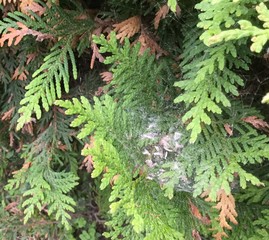 Arborvitae Leafminers (A complex of species) - Cedar in many parts of the state are showing browning from the feeding of arborvitae leafminers as well as other problems (see diseases). This is not new. There are four species of leafminers that feed on cedar in Maine. The larvae feed inside the needles causing them to turn brown. There will be a small hole in each mine that can be seen with a hand lens. This damage is easily confused with winter injury or damage from fungal pathogens. Mined tips will be hollow and will appear translucent if held up to a strong light. The larvae overwinter in the needles then resume feeding in the spring. The moths are now flying in the Bangor area, and have probably also emerged in southern Maine.
Photo: Spider webs, such as the one pictured, can help you determine whether you have a caterpillar among the causes of cedar-browning and when the adults fly. Or you can use the traditional method of shaking the trees. Maine Forest Service Photo.
High-value trees can be monitored for the presence of leafminer adults. From the end of June into early July periodically shake the branches of the trees and if clouds of tiny moths fly out, it is time to treat. Use a contact insecticide to kill the moths – they do not feed.
On lightly infested trees, this pest can be controlled by clipping and burning mine-containing leaves in fall or very early spring. In heavier infestations, treatment to control the moth stage is fairly effective and will prevent egg-laying. Repeated treatments may be necessary to control the adults as their flights may extend over several weeks. Another option is to wait until new mines appear in early August and treat at that time. Chlorpyrifos (Chlorpyrifos), Bifenthrin (Talstar) and Permethrin (Permethrin) are some of the contact insecticides registered for control of leafminers. These contact insecticides can be used on both adults and larvae. Control of larvae in mines using a contact insecticide is best achieved with an emulsifiable concentrate, however wettable powder sprays will provide adequate control and are less toxic for applications around home grounds. Acephate (Orthene) and Imidacloprid (Merit 75 WP) systemic insecticides are also registered for larval control within the mines.
|
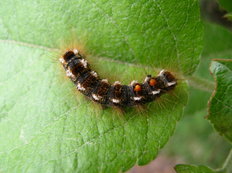 Browntail Moth (Euproctis chrysorrhoea) – Since the last Conditions Report there have been two new detections of significant populations of browntail moth. Burnham (Waldo County) and Eddington (Penobscot County) are the latest towns to join the ranks known to have browntail moth infestations. In both instances, the feeding has led to near complete defoliation of oaks in a forest stand. These detections reinforce the message that browntail moth is on the move. The caterpillars are easily moved on vehicles; the pupa can be moved on all manner of conveyance (wandering caterpillars find a cozy place to pupate, often one that is easily overlooked); and the moths can fly long distances and are attracted to lights.
Photo: Browntail moth caterpillar. Maine Forest Service Photo.
Browntail moth caterpillars have finished feeding or are winding down their feeding for the season. If you had significant populations this year, be aware that although the caterpillars are no longer out in abundance, their hairs are still in the environment. Pupal masses should be handled with extreme caution, as they contain the cast skin of the last instar the caterpillars (often dozens in a single mass). Exposure to the hairs and their toxins is most likely during dry, windy conditions. Please refer to the new browntail moth brochure for more information.
What’s next for this beast? They will spend a couple of weeks in their cocoons, then emerge in mid- to late July as moths. The moths (remember, attracted to lights) will lay eggs on the undersides of host leaves, the eggs hatch into caterpillars in late-July and early-August and begin skeletonizing the host leaves. The caterpillars begin to build their overwintering web in August. Remember, for low populations clipping and destroying the webs is a very effective control method.
|
 Emerald Ash Borer (Agrilus planipennis) – As was true last year, the purple traps deployed around the state have been hung by a federal contractor, Delta 21. Each trap should have an information card associated with it. If you find a trap that has been damaged or otherwise needs attention, please contact the number on the card: 866-322-5412. If you have other concerns regarding the program, you can contact Maine’s USDA APHIS, PPQ office in Hermon at (207) 848-0000.
Photo: Purple trap used in detection survey for emerald ash borer. Maine Forest Service Photo.
If the emerald ash borer were in Maine, we would expect to begin to see adults exiting infested trees now. When they exit, they create a D-shaped exit hole, similar to other Buprestids. If you suspect you’ve found an area infested by emerald ash borer, please report it to our office. You can find photos of the insect and damaged trees and a new MFS information sheet for landowners at www.maine.gov/eab.
|
Forest Tent Caterpillar (Malacosoma disstria) – Defoliation of northern red oak caused by forest tent caterpillar has been reported in Blue Hill and Brooksville (Hancock County). An abundance of the caterpillars not associated with significant defoliation have been reported in Stockholm (Aroostook County), Old Town (Penobscot County) and Bath (Sagadahoc County). In Blue Hill, moderate to severe defoliation is visible along Route 15 (Mines Road) for approximately one mile.
Forest tent caterpillars are wrapping up feeding for the season. In Hancock County this week, their cocoons were festooning plants and structures beneath the defoliated trees. Gypsy moth caterpillars were scattered amongst the remaining forest tent caterpillars, but the forest tent caterpillars were more abundant. However, gypsy moth will continue to feed after the forest tent caterpillars have pupated.
This is a native insect, with many natural controls, however during epidemic populations significant forest damage can occur. 2007 was the last time we mapped defoliation by forest tent caterpillar in Maine. The affected area comprised about 30 acres of primarily aspen in Aroostook County. The population crashed after a single year of recorded defoliation. Outbreaks frequently last for 2 to 4 years.
If you have noticed defoliation, do not assume someone else has already reported it, please let us know. In the case of the defoliation in Blue Hill, the defoliated trees are obvious along a significant stretch of busy route 15. There is no doubt that cars, decks and driveways were coated with frass for weeks. We received one report (which we’re very grateful for!). Your reports help us target ground and aerial surveys.
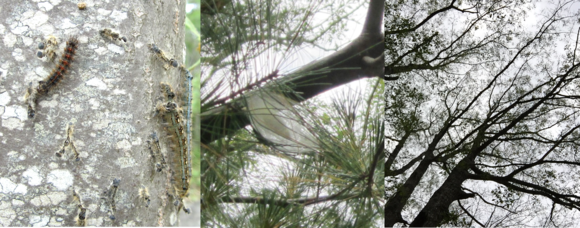 Images From left to right above: Gypsy moth (L) and forest tent caterpillars (R) along with cast skins of forest tent caterpillar; Cocoon of forest tent caterpillar in eastern white pine beneath defoliated northern red oak; Oak defoliation (Blue Hill). Maine Forest Service Photos.
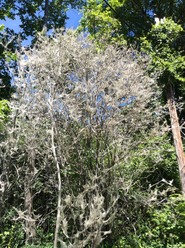 Uglynest Caterpillar (Archips cerasivorana) – Tree-engulfing webs were reported by a homeowner in Hebron (Oxford County). The culprit was determined to be uglynest caterpillar. This is mostly a nuisance and aesthetic pest; and is of little import from a tree-health standpoint. The webbing is impressive, though! You can find a thorough factsheet on the idtools.org website.
Webbing created by uglynest caterpillars in Hebron, ME. Photo: Maine Forest Service Photo.
|
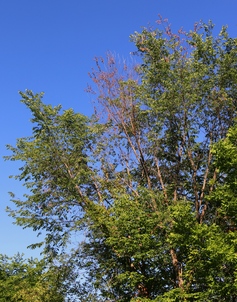 Dutch elm disease symptoms are beginning to be noticeable across Maine where elms grow. Symptoms include wilting, followed by reddening of foliage and progressive dieback from the point of infection to interior portions of the tree. While pruning out infected limbs can be attempted, this rarely effectively stops the disease from killing the tree. Mortality typically happens within three years of initial infection – although trees can die the same year they are infected. Although Dutch elm disease is present throughout Maine, actions by homeowners can influence how fast the disease spreads to nearby trees in their neighborhood. Current recommendations include immediate treatment/ removal of the infected tree, with the wood either debarked, burned, or buried to prevent insects from using the wood as breeding material. It is in this wood that elm bark beetles mate, mature, overwinter and are exposed to the spores of the Dutch elm disease fungus. When the beetles emerge in spring, covered with Dutch elm disease spores, they feed on the branches of healthy elm trees, transmitting the disease. There are two different elm bark beetle species known to transmit the disease in Maine (Scolytus multistriatus and Hylurgopinus rufipes). A third, S. schevyrewi, has been found in many states including Connecticut, New York, New Jersey and Pennsylvania, but has not yet been found in Maine.
Photo: Flagging branches affected by the Dutch elm disease wilt fungus. Maine Forest Service Photo.
|
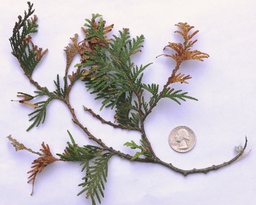 Pestilotiopsis tip blight of arborvitae (Pestilotiopsis funera) has been seen in many locations in Maine in natural and horticultural settings. This disease, causing orange branch tips due to infection and dieback, is often associated with poor tree/shrub health and injury. Pestilotiopsis tip blight is often connected to unfavorable environmental conditions, is seldom a severe threat to tree/shrub health (although aesthetic impacts may be significant) and is quite straightforward to manage.
Photo: Arborvitae with dead tips infected with Pestilotiopsis funerea. Maine Forest Service Photo.
Dead branch tips should be pruned several inches below the last part of a symptomatic branch. When pruning diseased plant material, it is always a good precaution to sterilize
pruning shears between cuts to prevent accidentally spreading the disease you are trying to eliminate. Supplemental fertilizer can be applied to support tree health, but not after the middle of July, as that can stimulate the production of succulent growth. This succulent growth is vulnerable to winter damage because it may not harden off before freezing temperatures. Avoid directly wetting arborvitae foliage (or any parts of any trees for that matter) with water from sprinkler systems, as this prolongs the period during which spores can be produced, spread, germinate and penetrate/infect host tissues. Chemical fungicides are seldom needed to bring this tip blight under control, although fungicides containing the active ingredient ‘chlorothalonil’ have been shown to be effective at maximizing aesthetic quality and tree/shrub health when applied before the period of spore production, beginning now during periods of high relative humidity (rain, fog or from irrigation systems).
*Pestilotiopsis tip blight may be confused with arborvitae leaf miners (see information about this in the ‘Insects’ section of this issue of the Conditions Report).
|
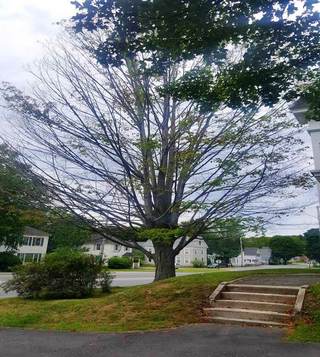 Maple trees failing to leaf out properly has been a frequently reported issue in Maine during the months of May and June. All species of maple seem to be affected. Several field visits to address this issue have resulted in common findings: no fungal, bacterial or viral disease has been seen to be associated with this. Further, insects have not been seen to be associated with the issue; only in a few cases what appears to be heavy pear thrips damage was noted (this damage is characterized by small, malformed leaves with tattering of various parts of the inner and marginal parts of leaves). However, since thrips damage occurs very early in spring, after which the thrips transition to an underground part of their life cycle, this has not been confirmed. So, in the absence of insect or disease evidence, there are a few theories about what may be happening that center on environmental conditions that could, alone or in concert, be causing the observed symptoms.
Photo: A sugar maple in Gorham that failed to fully leaf out this spring. Meribeth Leach Photo.
The growing season of 2016 was historically dry. This may have led to inadequate moisture for normal tree growth and health maintenance including varying degrees of fine root dieback. This may have led to poor bud development (buds for the 2017 growing season formed in 2016) and even dieback of branches in the upper crown. Other symptoms include late foliage, small foliage, no foliage on some parts of trees, discolored foliage and heavy seeding.
Abnormal/incomplete leaf development can be caused by several things from lack of resources to herbicide injury. In the cases seen this year, the cause is likely environmental and related to the 2016 drought. Trees affected by this may only partially leaf out this year, they may push out a late flush of small leaves, they may suffer various degrees of branch dieback and some may die completely.
Discolored foliage is likely the result of the prolonged cold and wet soils this spring leading to nutrient deficiencies causing maple leaves to be yellowish or purplish. This effect may be enhanced on more alkaline (less acidic) soils. The needed nutrients are actually present in adequate amounts in the soil, but due to inundated and cold soil, the chemical processes on the cellular level needed for the roots to absorb enough crucial nutrients for normal leaf development occur too slowly.
Heavy seed years are not abnormal for healthy trees of some species. For example, oaks have evolved this habit to increase regeneration success.
However, heavy seeding in response to stress events can be an indication of a serious tree health problem. If a tree is shifting its energy reserves from leaf production to seed production, the tree may be making a last effort at reproduction before it dies.
In closing, the current recommendation is to ‘wait and see’. While some maples will certainly die, others may recover and leaf out fully next spring. In this meantime, efforts to support tree health can be considered such as supplemental watering during times of drought and fertilization. However, excessive watering and fertilization too late in the summer (typically not after mid-July) could lead to late flushes of growth that may not harden off soon enough in fall and be vulnerable to freeze damage, further stressing trees.
|
White pine needle diseases (Lecanosticta acicola, Lophophacidium dooksii, Bifusella linearis and others) – The yellowing, browning, and premature shedding of one-year-old needles of white pines is currently occurring throughout all regions where white pine grows in Maine. A recent aerial survey flight by the Maine Forest Service documented widespread yellowing of needles and thin crowns. Disease intensity was noticed to be most severe in areas near bodies of water. Needles are expected to continue to shed well into July as infected needles turn reddish brown. Small black dots or black lines may be seen on shed needles – these are the spore-producing structures of the causal fungi. Nothing needs to be done with these shed needles, as they have already released spores and re-infected newly emerging pine needles before being cast to the ground, where their ability to cause infection is minimal.
The Maine Forest Service has been leading a multi-state effort to address challenges posed by the long-term effects of white pine needle disease and other white pine decline issues. The states of Maine, New Hampshire, Massachusetts, Vermont, New York and Rhode Island have been awarded a regional Evaluation and Monitoring grant by the US Forest Service and will be joining and focusing efforts over the next two years.
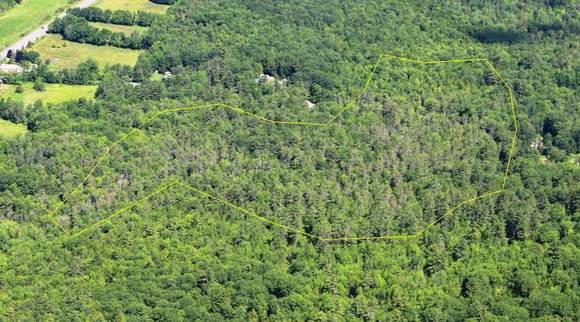 Photo Above: A white pine stand showing symptoms of present and past infection by white pine needle diseases. Note the greyish, thin appearance of the crowns. Maine Forest Service Image.
Office Hours are 7:30 a.m. to 4:00 p.m., Monday through Friday, except for holidays.
If you plan to visit either office, you may wish to call ahead just to make sure someone will be present to meet with you. (207) 287-2431 (Augusta) and 827-1813 (Old Town).
Conditions Report No. 3, 2017
On-line: http://maine.gov/dacf/mfs/publications/condition_reports.html
DEPARTMENT OF AGRICULTURE CONSERVATION & FORESTRY
Maine Forest Service - Forest Health and Monitoring
Contributors: Aaron Bergdahl, Allison Kanoti
|